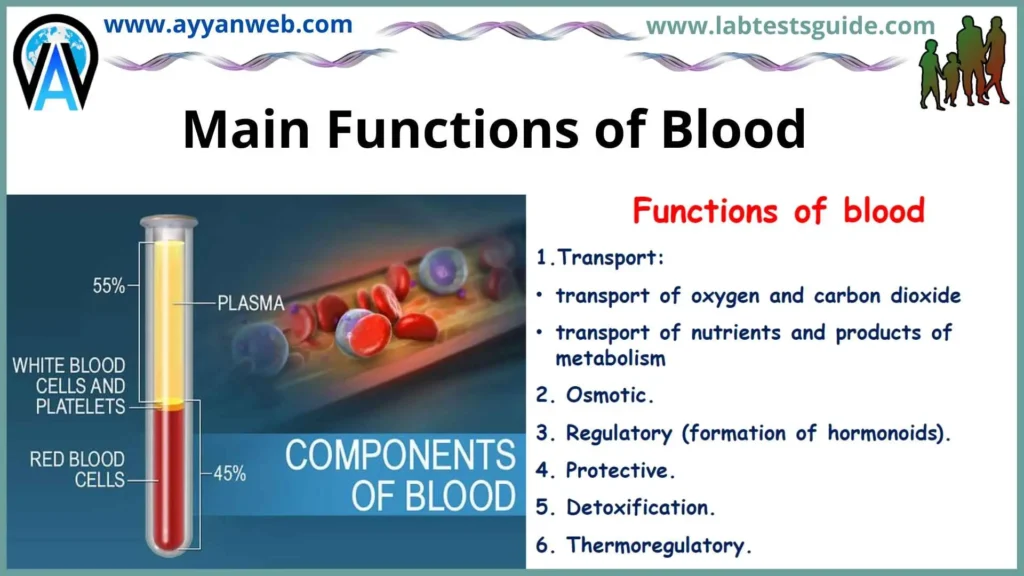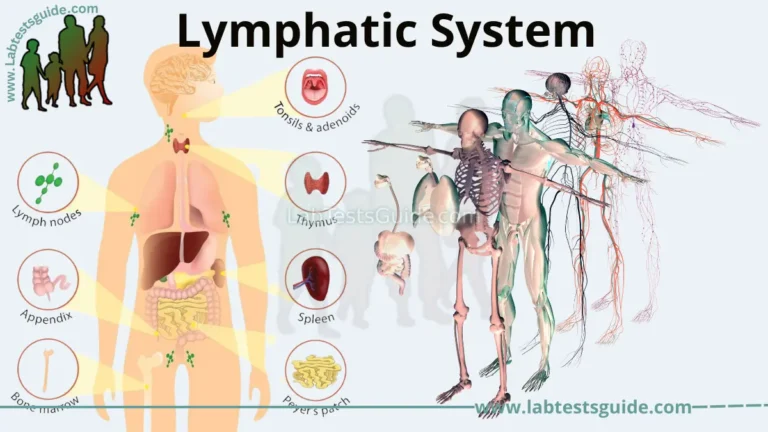Blood is a specialized body fluid. It has four main Blood components: Plasma, Red Blood Cells, White Blood Cells, and platelets. Blood has many different Blood functions, including:
- Transporting oxygen and nutrients to the lungs and tissues
- Forming blood clots to prevent excess blood loss
- Carrying cells and antibodies that fight infection
- Bringing waste products to the kidneys and liver, which filter and clean the blood
- Regulating body temperature

The blood that runs through the veins, arteries, and capillaries is known as whole blood, a mixture of about 55 percent plasma and 45 percent blood cells. About 7 to 8 percent of your total body weight is blood. An average-sized man has about 12 pints of blood in his body, and an average-sized woman has about nine pints.
What is Blood ?
Blood is a fluid connective tissue that consists of plasma, blood cells and platelets. It circulates throughout our body delivering oxygen and nutrients to various cells and tissues. It makes up 8% of our body weight. An average adult possesses around 5-6 litres of blood.
ABO and RH Factor
ABO Grouping:
The ABO blood group system classifies blood types according to the different types of antigens in the red blood cells and antibodies in the plasma.
They use the ABO system alongside the RhD antigen status to determine which blood type or types will match for a safe red blood cell transfusion.
There are four ABO groups:
Group A: The surface of the red blood cells contains A antigen, and the plasma has anti-B antibody. Anti-B antibody would attack blood cells that contain B antigen.
Group B: The surface of the red blood cells contains B antigen, and the plasma has anti-A antibody. Anti-A antibody would attack blood cells that contain A antigen.
Group AB: The red blood cells have both A and B antigens, but the plasma does not contain anti-A or anti-B antibodies. Individuals with type AB can receive any ABO blood type.
Group O: The plasma contains both anti-A and anti-B antibodies, but the surface of the red blood cells does not contain any A or B antigens. Since these antigens are not present, a person with any ABO blood type can receive this type of blood.
Rhesus factor
Some red blood cells have Rh factor, also known as the RhD antigen. Rhesus grouping adds another dimension.
If the red blood cells contain the RhD antigen, they are RhD positive. If they do not, they are RhD negative.
Understanding ABO and Rhesus
Doctors need to take into account both ABO and Rh when considering blood types. This means there are eight main blood types in the ABO/Rh blood group system. Some are more common than others.
According to the American Association of Blood Banks, the distribution of blood types in the U.S. are as follows:
| ABO blood type | Percentage of people |
| A-positive (A+) | 30% |
| A-negative (A-) | 6% |
| B-positive (B+) | 9% |
| B-negative (B-) | 2% |
| AB-positive (AB+) | 4% |
| AB-negative (AB-) | 1% |
| O-positive (O+) | 39% |
| O-negative (O-) | 9% |
Main Componants of Blood:
1. What is Plasma ?
Plasma is the liquid portion of your blood. Plasma is yellowish in color and consists mainly of water, but it also contains proteins, sugars, hormones, and salts. It transports water and nutrients to the tissues of your body. Read More about Plasma
2. What is White Blood Cells (WBCs) ?
Although white blood cells (leukocytes) only make up about 1% of the blood, they are very important. White blood cells are essential for good health and protection against disease and illness. Like red blood cells, they are constantly generated from the bone marrow. They flow through the bloodstream and attack foreign bodies, such as viruses and bacteria. They can even leave the bloodstream to spread the fight to the tissue. Read more about WBCs
3. What is Red Blood Cells (RBCs) ?
Red blood cells make up 40%-45% of your blood volume. They are generated from the bone marrow at a rate of four to five billion per hour. They have a life cycle of about 120 days in the body. Read more about RBCs
4. What is Platelets ?
Platelets are an amazing part of your blood. Platelets are the smallest of our blood cells and literally look like little plaques in their non-active form. Platelets control bleeding. Wherever a wound occurs, the blood vessel will send a signal. The platelets receive that signal and travel to the area and transform into their “active” formation, developing long tentacles to contact the vessel and form clumps to cover the wound until it heals. Read more about Platelets
What is The Functions of Blood ?
Main Functions of Blood:

- Transport:
- Transport of Oxygen and Carbon dioxide
- transport of nutrients and products of metabolism
- Osmotic.
- Regulatory (formation of hormonoids).
- Protective.
- Detoxification.
- Thermoregulatory.
Blood has many Functions:
- Above all, blood carries oxygen from the lungs to all tissues by means of hemoglobin that is embedded in red blood cells. On the way back to the heart and lungs, it carries CO2, which is exhaled through the lungs.
- Nutrients are absorbed in the capillaries of the intestine and transported through the portal vein to the liver. Here many metabolic pathways are followed and nutrients are further transported through the blood to all cells in the body.
- The coagulation factors in the blood plasma together with the platelets contained in the blood ensure that any small tear or hole is covered immediately. Blood has a certain arterial pressure, so any defect cannot be tolerated or this could lead to significant bleeding. Interestingly, clotting factors/platelets and fibrinolysis constantly balance each other automatically.
- The infection is being contained by white blood cells (lymphocytes for viruses, neutrophils for bacteria) on the one hand and plasma cell antibodies on the other. This is a fairly effective system for fighting infections. From time to time antibiotics are needed when our immune systems are overwhelmed.
- Hormones and other signaling molecules (for example, nitric oxide) integrate the function of various organs. As long as all the hormones are present and balanced, we have energy and all our organs work perfectly. But when hormones are lacking, we feel miserable. As we age, some hormones are not produced enough. Having reviewed the literature, bioidentical hormone replacement will allow our system to rebalance itself.
- Heat distribution and blood redistribution are another aspect of perfusing our extremities with blood, our abdominal organs, head, and skin. After a meal, blood rushes to the intestine and liver as we begin to digest our food. We may get tired because some of the blood from the brain is drawn into the stomach, small intestine, and liver. On a hot day, the veins in our skin open up, we sweat and lose some of our body heat through the skin. It’s the body’s way of keeping us cool on the inside.
- There is one aspect that seems to be out of our control. When we get excited or a person is extremely shy, the head, neck and ears will turn red. This is out of our control. Some people have this more than others and some don’t have it at all. It comes from dilated blood vessels in the skin. When they are dilated, blood rushes to that region, giving the skin a reddened appearance.
FAQs
What is blood?
Blood is a fluid connective tissue that comprises red blood cells, white blood cells, platelets, and plasma. The main function of blood is to carry oxygen and nutrients to various cells and tissues in the body.
What types of blood cells found in human blood ?
Blood cells are classified into the following types:
What is different types of white blood cells found in the blood ?
White blood cells can be classified as follows:
What are granulocytes?
Granulocytes are leukocytes with granule-like structures, containing enzymes capable of digesting microorganisms. Granulocytes are further classified into eosinophils, basophils, and neutrophils.
What are agranulocytes?
Agranulocytes are a type of white blood cell that does not have defined granules in its cytoplasm. However, they form an important part of the body’s immune system. They are further classified into monocytes and lymphocytes.
What is the Name of various components of blood ?
Blood is broken down mainly into the following components:
What are the 8 main functions of blood?
- Blood Is Fluid Connective Tissue
- Blood Provides the Body’s Cells with Oxygen and Removes Carbon Dioxide
- Blood Transports Nutrients and Hormones
- Blood Regulates Body Temperature
- Platelets Clot Blood at Sites of Injury
- Blood Brings Waste Products to the Kidneys and Liver
- Red Blood Cells Are the Most Numerous Living Cells in Blood
- White Blood Cells Protect the Body from Pathogens
What is the main importance of blood ?
Blood brings oxygen and nutrients to all the parts of the body so they can keep working.
Possible References Used







